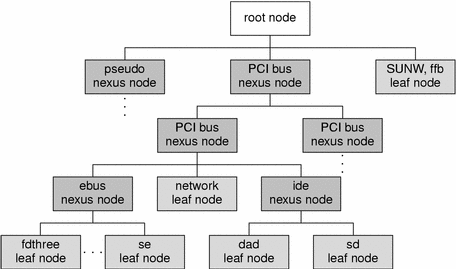Device Tree Components
The system builds a tree structure that contains information about the devices connected to the machine at boot time. The device tree can also be modified by dynamic reconfiguration operations while the system is in normal operation.
The tree begins at the "root" device node, which represents the platform. Below the root node are "branches" of the device tree, where a branch consists of one or more bus nexus devices and a terminating leaf device.
A bus nexus device provides bus mapping and translation services to devices that are subordinate to it in the device tree. PCI - PCI bridges, PCMCIA adapters, and SCSI HBAs are all example of nexus devices. The discussion of writing drivers for nexus devices is limited to that of developing SCSI HBA drivers (see Chapter 15, SCSI Host Bus Adapter Drivers).
Leaf devices are typically peripheral devices such as disks, tapes, network adapters, frame buffers, and so forth. Drivers for these devices export the traditional character and block driver interfaces for use by user processes to read and write data to storage or communication devices.
Each driver exports a device operations structure dev_ops(9S) that defines the operations that the device driver can perform. The device operations structure contains function pointers for generic operations such as attach(9E), detach(9E), and getinfo(9E). It also contains a pointer to a set of operations specific to bus nexus drivers and a pointer to a set of operations specific to leaf drivers.
The tree structure creates a parent-child relationship between nodes. This parent-child relationship is the key to architectural independence. When a leaf or bus nexus driver requires a service that is architecturally dependent in nature, it requests its parent to provide the service. This approach enables drivers to function regardless of the architecture of the machine or the processor. A typical device tree is shown in the following figure.
Figure 1-2 Example Device Tree

The nexus nodes may have one or more children, and the leaf nodes represent individual devices.
Displaying the Device Tree
The device tree can be displayed in three ways:
The libdevinfo library provides interfaces to access the contents of the device tree programmatically.
The prtconf(1M) command displays the complete contents of the device tree.
The /devices hierarchy is a representation of the device tree; use ls(1) to view it.
Note - /devices displays only devices that have drivers configured into the system. prtconf(1M) shows all device nodes regardless of whether a driver for the device exists on the system.
The libdevinfo Library
The libdevinfo library provides interfaces for accessing all public device configuration data. See the libdevinfo(3DEVINFO) man page for a list of interfaces.
The prtconf Command
The prtconf(1M) command (excerpted example follows) displays all the devices in the system:
System Configuration: Sun Microsystems sun4u
Memory size: 128 Megabytes
System Peripherals (Software Nodes):
SUNW,Ultra-5_10
packages (driver not attached)
terminal-emulator (driver not attached)
deblocker (driver not attached)
obp-tftp (driver not attached)
disk-label (driver not attached)
SUNW,builtin-drivers (driver not attached)
sun-keyboard (driver not attached)
ufs-file-system (driver not attached)
chosen (driver not attached)
openprom (driver not attached)
client-services (driver not attached)
options, instance #0
aliases (driver not attached)
memory (driver not attached)
virtual-memory (driver not attached)
pci, instance #0
pci, instance #0
ebus, instance #0
auxio (driver not attached)
power, instance #0
SUNW,pll (driver not attached)
se, instance #0
su, instance #0
su, instance #1
ecpp (driver not attached)
fdthree, instance #0
eeprom (driver not attached)
flashprom (driver not attached)
SUNW,CS4231 (driver not attached)
network, instance #0
SUNW,m64B (driver not attached)
ide, instance #0
disk (driver not attached)
cdrom (driver not attached)
dad, instance #0
sd, instance #15
pci, instance #1
pci, instance #0
pci108e,1000 (driver not attached)
SUNW,hme, instance #1
SUNW,isptwo, instance #0
sd (driver not attached)
st (driver not attached)
sd, instance #0 (driver not attached)
sd, instance #1 (driver not attached)
sd, instance #2 (driver not attached)
....
SUNW,UltraSPARC-IIi (driver not attached)
SUNW,ffb, instance #0
pseudo, instance #0
|
The /devices Directory
The /devices hierarchy provides a name space representing the device tree. Following is an abbreviated listing of the /devices name space. The sample output corresponds to the example device tree and prtconf(1M) output shown previously.
/devices /devices/pseudo /devices/pci@1f,0:devctl /devices/SUNW,ffb@1e,0:ffb0 /devices/pci@1f,0 /devices/pci@1f,0/pci@1,1 /devices/pci@1f,0/pci@1,1/SUNW,m64B@2:m640 /devices/pci@1f,0/pci@1,1/ide@3:devctl /devices/pci@1f,0/pci@1,1/ide@3:scsi /devices/pci@1f,0/pci@1,1/ebus@1 /devices/pci@1f,0/pci@1,1/ebus@1/power@14,724000:power_button /devices/pci@1f,0/pci@1,1/ebus@1/se@14,400000:a /devices/pci@1f,0/pci@1,1/ebus@1/se@14,400000:b /devices/pci@1f,0/pci@1,1/ebus@1/se@14,400000:0,hdlc /devices/pci@1f,0/pci@1,1/ebus@1/se@14,400000:1,hdlc /devices/pci@1f,0/pci@1,1/ebus@1/se@14,400000:a,cu /devices/pci@1f,0/pci@1,1/ebus@1/se@14,400000:b,cu /devices/pci@1f,0/pci@1,1/ebus@1/ecpp@14,3043bc:ecpp0 /devices/pci@1f,0/pci@1,1/ebus@1/fdthree@14,3023f0:a /devices/pci@1f,0/pci@1,1/ebus@1/fdthree@14,3023f0:a,raw /devices/pci@1f,0/pci@1,1/ebus@1/SUNW,CS4231@14,200000:sound,audio /devices/pci@1f,0/pci@1,1/ebus@1/SUNW,CS4231@14,200000:sound,audioctl /devices/pci@1f,0/pci@1,1/ide@3 /devices/pci@1f,0/pci@1,1/ide@3/sd@2,0:a /devices/pci@1f,0/pci@1,1/ide@3/sd@2,0:a,raw /devices/pci@1f,0/pci@1,1/ide@3/dad@0,0:a /devices/pci@1f,0/pci@1,1/ide@3/dad@0,0:a,raw /devices/pci@1f,0/pci@1 /devices/pci@1f,0/pci@1/pci@2 /devices/pci@1f,0/pci@1/pci@2/SUNW,isptwo@4:devctl /devices/pci@1f,0/pci@1/pci@2/SUNW,isptwo@4:scsi |




